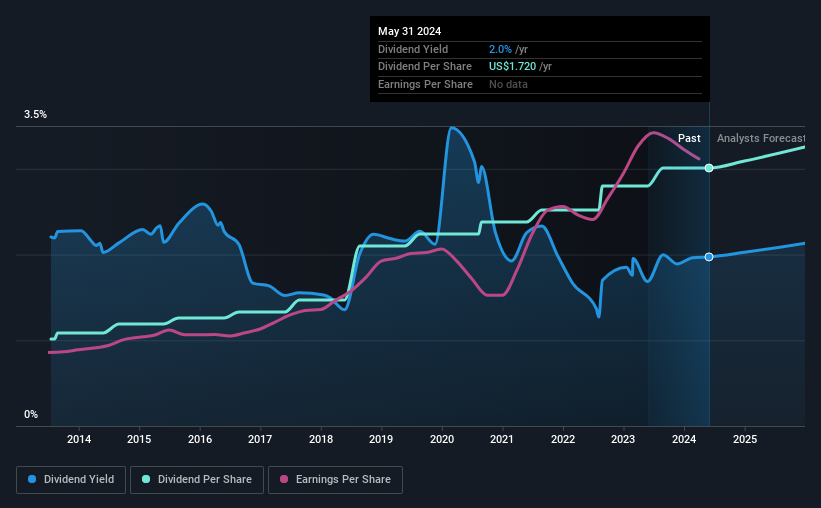BancFirst Corporation's (NASDAQ:BANF) investors are due to receive a payment of $0.43 per share on 15th of July. Despite this raise, the dividend yield of 2.0% is only a modest boost to shareholder returns.
View our latest analysis for BancFirst
BancFirst's Payment Expected To Have Solid Earnings Coverage
While yield is important, another factor to consider about a company's dividend is whether the current payout levels are feasible.
BancFirst has established itself as a dividend paying company with over 10 years history of distributing earnings to shareholders. Based on BancFirst's last earnings report, the payout ratio is at a decent 27%, meaning that the company is able to pay out its dividend with a bit of room to spare.
Looking forward, earnings per share is forecast to fall by 6.2% over the next year. But assuming the dividend continues along recent trends, we believe the future payout ratio could be 33%, which we are pretty comfortable with and we think would be feasible on an earnings basis.

BancFirst Has A Solid Track Record
The company has an extended history of paying stable dividends. The dividend has gone from an annual total of $0.58 in 2014 to the most recent total annual payment of $1.72. This works out to be a compound annual growth rate (CAGR) of approximately 11% a year over that time. It is good to see that there has been strong dividend growth, and that there haven't been any cuts for a long time.
The Dividend Has Growth Potential
Some investors will be chomping at the bit to buy some of the company's stock based on its dividend history. BancFirst has seen EPS rising for the last five years, at 9.7% per annum. A low payout ratio and decent growth suggests that the company is reinvesting well, and it also has plenty of room to increase the dividend over time.
BancFirst Looks Like A Great Dividend Stock
Overall, we think this could be an attractive income stock, and it is only getting better by paying a higher dividend this year. The earnings easily cover the company's distributions, and the company is generating plenty of cash. We should point out that the earnings are expected to fall over the next 12 months, which won't be a problem if this doesn't become a trend, but could cause some turbulence in the next year. All in all, this checks a lot of the boxes we look for when choosing an income stock.
Investors generally tend to favour companies with a consistent, stable dividend policy as opposed to those operating an irregular one. At the same time, there are other factors our readers should be conscious of before pouring capital into a stock. Case in point: We've spotted 2 warning signs for BancFirst (of which 1 is significant!) you should know about. If you are a dividend investor, you might also want to look at our curated list of high yield dividend stocks.
Valuation is complex, but we're here to simplify it.
Discover if BancFirst might be undervalued or overvalued with our detailed analysis, featuring fair value estimates, potential risks, dividends, insider trades, and its financial condition.
Access Free AnalysisHave feedback on this article? Concerned about the content? Get in touch with us directly. Alternatively, email editorial-team (at) simplywallst.com.
This article by Simply Wall St is general in nature. We provide commentary based on historical data and analyst forecasts only using an unbiased methodology and our articles are not intended to be financial advice. It does not constitute a recommendation to buy or sell any stock, and does not take account of your objectives, or your financial situation. We aim to bring you long-term focused analysis driven by fundamental data. Note that our analysis may not factor in the latest price-sensitive company announcements or qualitative material. Simply Wall St has no position in any stocks mentioned.
About NasdaqGS:BANF
BancFirst
Operates as the bank holding company for BancFirst that provides a range of commercial banking services to retail customers, and small to medium-sized businesses in the United States.
Flawless balance sheet established dividend payer.
Similar Companies
Market Insights
Community Narratives


Recently Updated Narratives

Astor Enerji will surge with a fair value of $140.43 in the next 3 years

Proximus: The State-Backed Backup Plan with 7% Gross Yield and 15% Currency Upside.


A case for for IMPACT Silver Corp (TSXV:IPT) to reach USD $4.52 (CAD $6.16) in 2026 (23 bagger in 1 year) and USD $5.76 (CAD $7.89) by 2030
Popular Narratives


MicroVision will explode future revenue by 380.37% with a vision towards success


The company that turned a verb into a global necessity and basically runs the modern internet, digital ads, smartphones, maps, and AI.



